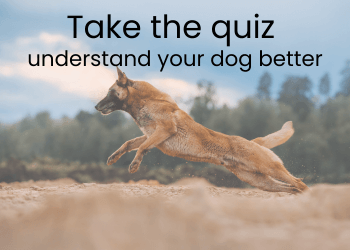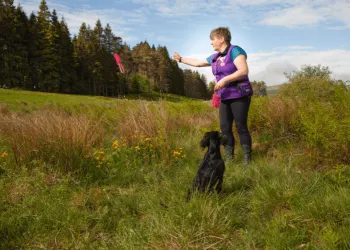
Wondering about your dog's prey drive?
Take the quiz that’s helped thousands of dog owners understand what’s going on with their dog.
I hear people say that loads. They say it with a feeling of relief that their dog doesn’t want to catch small animals or birds. Of course that’s what happens – companion dogs are meant to be kind and gentle to all. Even chasing prey is frowned on but at least the dogs who “just” chase aren’t going to cause any harm to the prey. That’s where the relief comes in.
For many dog owners, their dog chasing wildlife or birds is one of the most stressful parts of their walk. But, the massive elephant in the room is that dogs are descended from predators. Even though dogs diverged from wolves at least 15,000 years ago, they remain so closely related that wolves and dogs can still get together and create fertile offspring. Something that only happens when animals are essentially the same species.
I’m not finished with this yet. Domestic dogs differ from wolves in many ways – significant in their differences is what has happened to the prey drive of dogs.
Dogs have been carefully and selectively bred to retain a high prey drive but one that means they are less likely to eat prey. Wolves are interested in prey when they are hungry. There are many accounts of wolves and prey animals sharing spaces calmly during times when the wolves don’t need to eat.
On the other hand, dogs have been bred to perform short parts of predatory behaviour repeatedly without ever tiring of it or needing to eat the prey. No wolf would exhaust themselves spending a day running up to birds and making them fly into the air. They’d either catch a bird and eat or go off and find some other food. The hunting gundogs however, will spend entire days searching for birds, running up to them and making them fly into the air without ever eating one of the birds. They get great satisfaction from that short predatory sequence. The dogs don’t need to be trained to want to find birds. Their attraction to birds is an innate part of them. All of the training is about helping them learn how to find birds in a way that is helpful to people.
It’s not just gundogs either. Most dog breeds were created specifically to have a strong interest of some sort in prey. This is not historic. Right now, it is easy to go out and get a puppy or a rescue dog from working stock of all sorts of breeds. Those dogs have prey drive baked into them. Yet now it is normal to demonise dogs for being interested in prey. It is normal to the extent that people will routinely feel sad if their dog chases prey but will breathe a sigh of relief if their dog is one of those that chases but doesn’t want to catch.
I’m going to share something with you that you probably haven’t considered – maybe because of all the shame and worry that floats around about high prey drive dogs.
What if the dogs who catch prey are actually easier to train than the ones who “just” chase?
Chasing is how dogs close the gap between themselves and prey. It’s needed by all wild predators and it is needed for many of those jobs dogs have been so carefully bred to do. When you choose to live with a dog, you are choosing to live with a being who is likely to want to chase things that move fast – like small animals and birds.
It is natural behaviour for dogs. Due the key part it plays in the evolution of dogs, it is something that is needed for welfare reasons. Without access to natural behaviour, all animals become stressed and many go on to develop behaviour problems. For dogs, behaviour problems linked to predatory behaviour range from reactivity to resource guarding to an inability to focus on anything other than prey.
AND YET . . .
. . . almost everybody living with a dog is under pressure to make sure their dog doesn’t chase – or WORSE, catch – small animals or birds or a range of other things.
That’s where the relief comes from at having a dog who chases but doesn’t catch. Having a dog who chases is bad news but it would be worse if they chased and caught prey.
Right?
We know that chasing is natural behaviour for dogs. We know that performing natural behaviour is good for welfare reasons.
If you make that mental shift then suddenly, having a dog who chases but doesn’t catch isn’t as easy as having a dog who chases with the intention of catching. In our new narrative, the most difficult sort of dog of all is a dog who lives to use their nose to search out prey but then doesn’t want to do anything with the prey.
Here’s why:
I love dogs with a high prey drive and have been living with them for over 20 years now. One of my dogs was unusual in that he would catch, kill and eatrabbits and birds. I have no doubt he would have done the same thing with roe deer but he wasn’t ever fast enough to catch one. Most dogs do not eat prey they catch but I had one of the rare dogs who did.
That dog was an independent breed and I had him when my dog training skills were poor. Yet - he was really easy to train to leave prey alone. I didn’t know it at the time – because I lacked experience – but what made it easy was the fact that he wanted to catch, kill and eat prey. Specifically, eat!
My training worked so well because I rewarded my dog with food. Over time my dog learned that he would always get food from me and would hardly ever manage to catch it himself. So he stopped chasing and started hanging out with me.
Did I mention I had very little experience?
Well – like many inexperienced people – I put my success down to having way more skill than I actually had.
So when I got a collie cross puppy with the intention of competing in dog sports, I was smugly confident of how well trained that puppy would be as an adult dog. I trained him just like I’d trained my catch, kill and eat dog because I knew it worked really well.
By the time that puppy was a year old, he was taking off on me. Sometimes he’d be gone for hours. I worked in an office at that time and more than once I had to phone my boss to take time off while I searched for my missing dog.
What went wrong?
Let me tell you.
What went wrong was that collie cross didn’t want to catch prey. He certainly didn’t want to eat it. He wanted to follow the scent of prey. That was all he wanted to do. If he ever found prey, he would chase the animal away or wait for it to go into undergrowth. Then he would go back to following the scent around.
I struggled because I couldn’t tell when he was going to take off. One second he’d be calmly trotting along in front of me and the next, he’d be gone. Nothing would be there to tell me it was going to happen. Then, once he was gone, he didn’t respond to anything I did.
Getting success with him – which I did – needed a whole different strategy. I still used rewards but I used them in a very different way than I had with my first dog. I had a whole lot to learn about dogs who love to search for prey using their nose.
My catching, killing and eating dog was tons easier to train and put himself at far less risk than my “he just wants to sniff” dog.
If you are going to use reward based training – which is what I would recommend you’d do for many reasons – you need rewards that are rewarding.
For a dog who wants to chase and catch, toys are an easier sell sell as a reward. If you use them consistently as well, they can become preferable to chasing prey. When the dogs learn they always get to catch the toy, it can easily become preferable to the uncertainty of chasing a squirrel or other small animal or bird.
Toys and food absolutely can and should be used with the dogs who just want to chase and with the dogs who just want to follow scent. It’s just that you want to go into it with the expectation that it’ll take longer to sell the food and toys to your dog as a great reward that they will take even if small animals and birds are around.

Take the quiz that’s helped thousands of dog owners understand what’s going on with their dog.
If your dog is:
. . . you are not alone.
But you do need to start your learning journey. I can help with that.
Join in with the Prey Drive Challenge. It’s a 3 week course delivered by email that’ll get you started with all of the basics that you need.
Oh – and did I mention it’s free?
Anyway, sign up for it and get started.
Chin, L. (2025) Dogs of the World: an illustrated compendium. London: Penguin Random House
Cooper, E., Zulch, H. and Mills, D.S., 2025. The role of breed versus personality and other demographic factors in predicting chasing behaviour in dogs. Applied Animal Behaviour Science. 282. DOI: https://doi.org/10.1016/j.applanim.2024.106463
McLennan, T., 2023. Does the attention a dog pays to their owner increase after the dog engages in activities that mimic the predatory preferences of that dog (Canis familiaris)?. Applied Animal Behaviour Science. 263. DOI: https://doi.org/10.1016/j.applanim.2023.105944
Mech, L.D., Smith, D.W. and MacNulty, D. R. (2015) Wolves on the hunt: The behavior of wolves hunting wild prey. Chicago: The University of Chicago Press

Would you like to be in the know?
Join my mailing list, get my monthly newsletter and be kept up to date about special offers via email.

I am the founder of Best Dog Learning and Stuff and a massive prey drive enthusiast. I've lived with high prey drive dogs for over 20 years and I love them. I run the awesome High Prey Drive Club where I help my members learn to have fabulous walks and happy lives with their high prey drive dogs.
I am a published researcher in my field with both my original research and my review of the literature looking at prey drive in dogs being published in the respected journal Applied Animal Behaviour Science.
I peer review for Applied Animal Behaviour Science to help bring quality research into the world.
I am the author of Canine aggression: Rehabilitating an aggressive dog with kindess and compassion.
I want to show you how easy and fun it can be to have a high prey drive dog.
If you'd like help with your dog, I'm ready to help you right now.